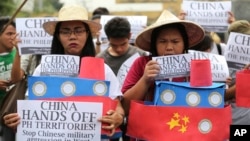Philippine officials say they are hopeful the country’s arbitration case against China over disputed territory in the South China Sea will be decided in April or May.
Philippine Foreign Affairs Spokesman Charles Jose said Thursday the department is basing its timeframe on how long it has taken the tribunal at the Permanent Court of Arbitration in The Hague to act between hearings.
China is not participating, but Jose said the court’s decision, whatever it may be, would stand.
“Even the court is telling China that the decision is binding on both the Philippines and China,” said Jose. “So the Philippines and other countries are calling on China to respect the forthcoming decision of the tribunal.”
In January 2013, the Philippines filed a complaint with the arbitral tribunal questioning what it called China’s “excessive claim” to practically the entire South China Sea. The Philippines cited China’s so-called nine-dash line, a U-shaped swath of the sea spanning from Hainan Island in the north to waters near Malaysia in the south.
It also wanted clarification on whether certain formations, which it said fell within its 370-kilometer exclusive economic zone, were rocks or islands.
China responded that it would not participate, reiterating that it rejects arbitration and had opted out of the dispute settlement mechanism when it signed onto the United Nations Convention on the Law of the Sea.
China Foreign Minister Wang Yi brought up this point last week during a debriefing at the Washington-based Center for Strategic and International Studies.
He also said the Philippines did not follow international rules when it did not meet one-on-one with China to try to resolve their differences in the South China Sea and instead “took [them] to international court.”
China says it has “indisputable sovereignty” over the South China Sea’s islands, based on historical maps. The Philippines, Vietnam, Malaysia, Taiwan and Brunei also have overlapping claims in the resource-rich, heavily traversed sea.
Philippines Foreign Affairs Secretary Albert del Rosario said in a statement this week that the Philippines and China had had “countless meetings” to try to resolve the issue, “to no avail.”
Maritime law professor Jay Batongbacal of the University of the Philippines Institute of International Law Studies said the tribunal will likely find in favor of Manila on some of the 15 issues raised by the Philippines. In particular, he said, it might deem the nine-dash line illegal.
If that happens, Batongbacal said, “The problem will really be on China’s part in the sense that it will… have to keep justifying, at every opportunity, whatever it does in the South China Sea, especially those actions that appear to contradict the ruling. So it will be harder for them basically to convince the world that their actions or activities are justifiable.”
Also, he said, the Philippines would have to “keep the pressure up on China” so that it changes its behavior and policies to conform to whatever will be directed in the decision.
In the past two years, China has turned seven formations, mostly disputed by the Philippines and listed in its case, into artificial islands. Beijing’s recent placements of missiles and radar stations on some of the islands have also raised tensions in the region.
Batongbacal said the court would not compel China to remove the artificial islands. But he said the court might put out a statement saying the construction of the islands is “inconsistent with China’s obligations under international law” because they were made while the case was pending and basically prejudiced the rights of the parties.
Batongbacal reiterated that whatever the tribunal decides, its mandate does not include determining the sovereignty of any of the disputed formations.













